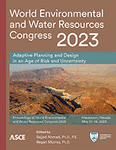Remediation of Urban Stormwater Using Best Management Practices and Low-Impact Development Green Infrastructure
Publication: World Environmental and Water Resources Congress 2023
ABSTRACT
Low-impact developments (LID) and best management practices (BMP) are methods that were devised to address hydrology and water quality concerns in urban and rural environments. BMPs are designed to remediate a predetermined drainage area and volumetric flow of stormwater runoff. BMP allows the water to either evapotranspiration or infiltrate into the ground allowing the water to reenter the water cycle at its own pace, recharging the groundwater and preventing flooding. The plants in the BMP provide the water treatment by absorbing, sequestering, vaporizing, or metabolizing the pollutants out of the water. The purpose of this study is to explore methodology for maintaining the long-term effectiveness of a BMP structure. There are many factors to determine the long-term effectiveness of a BMP such as the maintenance performed on the structure, the health of the plant life, the age of the structure, climate conditions, and public knowledge on the purpose of BMPs. After a while, the plants in the BMP will begin to die off, weeds and other invasive plant species crowd out the native plants in the structure, and the bed will fill with silt and trash. Part of the study is to determine how these factors impact performance and determine the critical threshold for addressing these problems. To establish a BMP performance index, it is necessary to first determine a benchmark for performance. The effectiveness of a BMP decreases over time and the amount of stormwater remediation decreases. The decrease in effectiveness over time can be charted and used to determine a maintenance schedule and important optimization milestones.
Get full access to this article
View all available purchase options and get full access to this chapter.
REFERENCES
Chesapeake Bay Foundation. (2021). “The Economic Importance of the Bay”. https://www.cbf.org/issues/what-we-have-to-lose/economic-importance-of-the-bay/.
Chesapeake Bay Program. (2021). “Facts and Figures”. https://www.chesapeakebay.net/discover/facts.
Kelly, M. (2018). Clean Water Action celebrates the Clean Water Act and the legacy of its founder, David Zwick, recommits to the fight to protect clean water. Clean Water Action.
Maryland Department of the Environment. (2000). “Maryland Stormwater Design Manual Volumes I & II.” https://mde.maryland.gov/programs/water/stormwatermanagementprogram/pages/stormwater_design.aspx.
Maryland Department of the Environment: Water and Science Administration, ‘StormwaterPrint’ Stormwater Design Manual.
Maryland Department of the Environment. (2021). “Stormwater Management” Stormwater Management Program, https://mde.maryland.gov/programs/water/stormwatermanagementprogram/pages/index.aspx.
Montgomery County Department of Environmental Protection. (2021). “Types of Stormwater Management Facilities”, https://www.montgomerycountymd.gov/water/stormwater/practices.html.
Maryland State Government. (2021). “Maryland at a Glance: Chesapeake Bay”. Maryland State Archives, https://msa.maryland.gov/msa/mdmanual/01glance/html/mdglance.html.
O’Donoghue, A. J. (2016). “Effects of algal blooms continue to spread throughout Wasatch Front.”.
Schlyer, K. (2021). “What is Killing the Bay?” Chesapeake Bay Foundation, https://www.cbf.org/how-we-save-the-bay/chesapeake-clean-water-blueprint/what-is-killing-the-bay.html.
USEPA. (1972). “Summary of the Clean Water Act”, https://www.epa.gov/laws-regulations/summary-clean-water-act.
USEPA. (1999). Phytoremediation Resource Guide. Solid Waste and Emergency Response, Washington, DC.
USEPA. (2007). Reducing Stormwater Costs through Low Impact Development (LID) Strategies and Practices. Nonpoint Source Control Branch, Washington, DC.
USEPA. (2021). “Urban Runoff: Low Impact Development”. Polluted Runoff: Nonpoint Source (NPS) Pollution. https://www.epa.gov/nps/urban-runoff-low-impact-development.
Williams, J. B. (2010). “Phytoremediation in Wetland Ecosystems: Progress, Problems, and Potential”. Critical Reviews in Plant Sciences. 21(6), 607–635.
Information & Authors
Information
Published In
History
Published online: May 18, 2023
ASCE Technical Topics:
- Best Management Practices (BMPs)
- Business management
- Environmental engineering
- Infrastructure
- Mitigation and remediation
- Municipal water
- Practice and Profession
- Stormwater management
- Sustainable development
- Urban and regional development
- Urban areas
- Water (by type)
- Water and water resources
- Water management
- Water treatment
- Water treatment plants
Authors
Metrics & Citations
Metrics
Citations
Download citation
If you have the appropriate software installed, you can download article citation data to the citation manager of your choice. Simply select your manager software from the list below and click Download.
